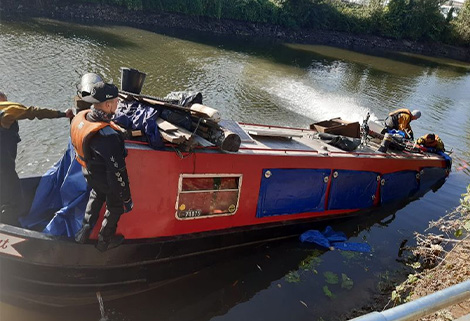coping with extreme weather
With the UK’s weather patterns becoming increasingly unpredictable, River Canal Rescue is advising owners how to manage their boats during extreme weather scenarios.
The emergency assistance and breakdown firm says the key to dealing with any situation is timing and balancing health and safety.
Managing director, Stephanie Horton, says: “In order to stop a vessel drifting onto land when water levels rise, position a scaffold pole or poles, or a boarding plank, between the boat and the river/canal side edge and fix it into position. This acts as a mooring post, preventing flood waters from floating the boat onto land.
“Alternatively use the engine to keep the vessel in position, so when the water rises, the power of the boat keeps it in deeper water. However be mindful that as the propeller is at its lowest point, it can easily be damaged if the boat does drift. These options are not advisable other than in emergencies and if you have the opportunity, moor in a lock as it provides some protection from flood waters.

“If the boat has drifted, it’s all about timing; when the water levels start to go down, try to push the boat back into the water or off the land before they drop too far. But be cautious as this can be dangerous, particularly if you’re unable to see under the water.
“River Canal Rescue usually dispatches two engineers in dry suits to undertake this manoeuvre because although it sounds and looks easy, knowing the best way to re-launch a boat and where to push depends on the severity of the grounding, depth of the water, its flow and accessibility.
“To reduce winter damage to boats, get into a routine of visiting your vessel regularly and check the batteries are fully charged. With a bilge pump in continuous operation even a fully charged battery will only last a few days.
“Check the bilge pumps are fully operational and left on ‘automatic’ setting. If there’s no bilge pump or only a manual one, install an automatic bilge pump. It needs reviewing because it relies on battery power, so unless the boat’s shore powered, there isn’t an unlimited supply.
“Ensure drain holes are clear of debris - keeping these clear will stop water running into the engine room, and secure canopies to prevent rips developing and water getting into the boat.
“Also check ropes and anchoring points, if the mooring’s at risk of flooding, run a rope to locations that can still be accessed even in a flood situation and ensure other ropes are loose enough to deal with the potential scenario of the pontoon going under.
“In windy conditions, check ropes for chafing and ensure they’re well positioned and adjusted to the conditions, and before moving a boat in ice, consider the importance of your journey. It’s easy to believe you’re impregnable when surrounded by steel but even a couple of inches of ice can pierce a hull.

“Check river/canal conditions, and again consider whether the journey is really necessary; they can change quickly and easily catch you unaware. Get updates from the Environment Agency. Never head out when a river is in red flag.
“And be aware of the wind direction before manoeuvring. When coupled with difficult river conditions, the windage of a boat can be easily underestimated and your vessel will become uncontrollable.
“If a vessel is caught in a situation, do not attempt a recovery without assistance. Severe weather conditions increase the risk to boat owners and simple tasks can easily result in accidents and injury.
“Finally, check your insurance policy. As insurance companies try to minimise their exposure, an increasing number of third-party only policies exclude salvage and wreck removal - one of the biggest risks to boats.”
In October last year, the UK faced severe downpours and over the last weekend of the month there were 90 flood warnings and 120 flood alerts in place, putting huge pressure on boaters who were faced with suddenly rising and falling water levels.
You can find RCR on Facebook, visit their website, call 01785 785680 or email

